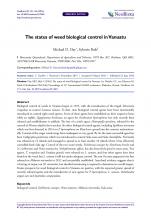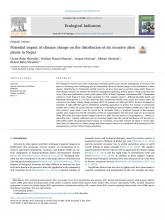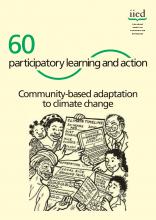Potential impact of climate change on the distribution of six invasive alien plants in Nepal.

BRB
Available Online
The biological invasions have been increasing at multiple spatial scales and the management of invasive alien species is becoming more challenging due to confounding effects of climate change on the distribution of those species. Identification of climatically suitable areas for invasive alien species and their range under future climate change scenarios areessentialfor long-term management planningofthesespecies. Using occurrence data of six of the most problematic invasive alien plants (IAPs) of Nepal (Ageratum houstonianum Mill., Chromolaenaodorata (L.) R.M. King & H. Rob., Hyptis suaveolens (L.) Poit., Lantana camara L., Mikania micrantha Kunth, and Parthenium hysterophorus L.), we have predicted their climatically suitable areas across the country under the current and two future climate change scenarios (RCP 4.5 scenarios for 2050 and 2070). We have developed an ensemble of eight different species distribution modelling approaches to predict the location of climatically suitable areas. Under the current climatic condition, P. hysterophorus had the highest suitable area (18% of the total countrys area) while it was the lowest for M. micrantha (12%). A predicted increase in the currently suitable areas ranges from 3% (M. micrantha) to 70% (A. houstonianum) with the mean value for all six species being 29% under the future climate change scenario for 2050. For four species (A. houstonianum, C. odorata, H.suaveolens and L. camara), additional areas at elevations higher than the current distribution will provide suitable habitat under the projected future climate. In conclusion, all six IAPs assessed are likely to invade additional areas in future due to climate change and these scenarios need to be considered while planning for IAPs management as well as climate change adaptation.









